How does a country grow? There are many cornerstones of this progress, like economic development and social development. When we talk about social development, it includes education, equality, healthcare, poverty alleviation, and overall well-being of people. India, over the decades, has made exceptional progress in these areas, coming from exploitation of being a British colony to surpassing the economy of the United Kingdom in size. Now, as we enter a new era, India needs to adopt best practices unique to the context of the country and accelerate its journey of progress. Having said that, there is a lot that India can learn from other countries to achieve this. In this article, we will explore the lessons that the country can draw from global examples.
Education: The Finland and Singapore Models
One of the most important foundation stones of social progress for any country is the quality of education that is provided to its citizens irrespective of their economic and social backgrounds. Many countries around the world have done great work in the field of education. However, Finland stands out in this area because of the innovations it has introduced in its education system. Singapore is another example from which India can learn.
If we look at Finland first, we can see that its education system puts greater emphasis on student well-being, equity and the quality of teachers. It ensures free and universal access to education, including transportation and meals. At the same time, Finland has shunned focusing on standardized examinations or testing of students, and its focus on holistic development. Teachers are provided regular training, and their professional development is supported through high investment initiatives.
Now, looking at Singapore, we can learn that they have focused heavily on skill development and learning as a lifelong process. It is especially important for countries like India that are emerging economies with large employable populations. If India puts a special emphasis on skilling of students, it can create a productive workforce that may attract global businesses to run their operations in the country.
Healthcare Initiatives in United Kingdom
The second most important element, although not in a chronological order, is a robust healthcare system that ensures access to good quality medical treatment to everyone. By having a good healthcare infrastructure, countries can save a lot of money that gets wasted because of illnesses that can be avoided, and also support families who are likely to go bankrupt in the event of a serious illness of any member.
There are many initiatives globally that India can learn from. We will look at the National Health Services (NHS) in the United Kingdom where universal healthcare is funded through taxes and it is made accessible to all citizens. India has already started on this path by providing a universal health insurance scheme funded by the government. At the same time, state governments have also been investing in this area.
Learning Gender Equality Interventions from Iceland and Rwanda
First of all, we must remember that these are examples chosen for the ease of understanding what India can learn. There are, obviously, many more initiatives in this area and others globally that can be highlighted. However, we are focusing on Iceland here because it has consistently been ranked as the most gender-equal country in the world and that is because of the many initiatives it has taken, like mandatory parental leave for both mothers and fathers, equal pay and wage transparency, and a significant presence of women in political and leadership roles. Similarly, Rwanda has also done a lot in the area of women empowerment as the country has the highest percentage of women in its parliament.
Poverty Alleviation Programmes in Bangladesh and Brazil
Recently, India has done a wonderful job of uplifting lakhs of people out of poverty. However, the country still has a long way to go. Poverty alleviation is also key to social development because it supports the people in many ways as they can take care of the basic needs, consume nutritional food, and spend money on education of their children. Here, India can learn from Brazil which has the Bolsa Familia Program that is a conditional cash transfer program. Under this, the government provides financial assistance to low-income families if they commit to meeting education and health requirements as set by the government.
On the other hand, Bangladesh has done a great job of promoting micro entrepreneurship in the country through its microfinance institution called Grameen Bank which provides non-collateral small loans to those who need it. Using this money, people get into new ways of earning their livelihood, and in some cases employing others as well. This way, poverty alleviation becomes a structural process with everyone participating in it.
Bhutan and New Zealand’s Community Engagement
Lastly, we will look at how India can take lessons in community engagement from countries like New Zealand and Bhutan. Community engagement means ensuring that there is social cohesion in the country and all population groups thrive together. In New Zealand, the Maori community has been assimilated with the population through emphasis on indigenous rights and cultural heritage. Maori people also have a strong presence in the New Zealand parliament which makes them feel included. Similarly, in Bhutan, the government measures Gross National Happiness (GNH) which prioritizes well-being over economic growth. Bhutan has also shown that it is dedicated towards environment conservation and supporting equitable development. This means, no social groups are excluded from the growth and everyone’s happiness or well-being is taken into consideration.
India’s Challenges
While all of these are great examples that India can learn from, we must also remember that the country has unique circumstances and challenges too. Therefore, it cannot straight away copy the initiatives from other countries. These need to be contextualized and modified as per Indian requirements. For example, India’s diversity is its strength but also a great challenge because it means that the country needs to invest in unique initiatives to promote social cohesion addressing specific needs of religions, communities, and demographics.
Additionally, the large population of India means that programs must be designed in a way that they can be scaled to that level. Lastly, collaboration within different government agencies, political groups, private sector, and non government organizations is also essential for implementation of these initiatives in India because of the complexity of its demographics.
Conclusion
India stands at a crossroads in its journey toward social development. By learning from the successes and challenges of other countries, India can adopt innovative approaches to education, healthcare, gender equality, skilling the youth, and involving children for the welfare of underserved children. These lessons, when adapted to India’s context, have the potential to create a more inclusive and equitable society.









